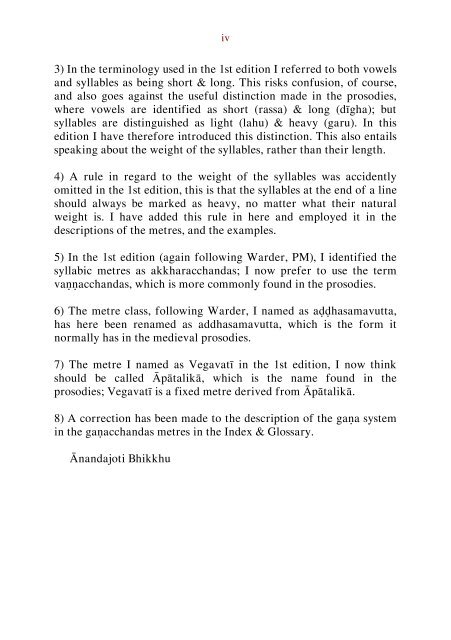An Outline of the Metres in the Pāḷi Canon
A concise but thorough explanation of the metres that are found in the Pāli canon, along with examples and glossary.
A concise but thorough explanation of the metres that are found in the Pāli canon, along with examples and glossary.
Create successful ePaper yourself
Turn your PDF publications into a flip-book with our unique Google optimized e-Paper software.
iv<br />
3) In <strong>the</strong> term<strong>in</strong>ology used <strong>in</strong> <strong>the</strong> 1st edition I referred to both vowels<br />
and syllables as be<strong>in</strong>g short & long. This risks confusion, <strong>of</strong> course,<br />
and also goes aga<strong>in</strong>st <strong>the</strong> useful dist<strong>in</strong>ction made <strong>in</strong> <strong>the</strong> prosodies,<br />
where vowels are identified as short (rassa) & long (dīgha); but<br />
syllables are dist<strong>in</strong>guished as light (lahu) & heavy (garu). In this<br />
edition I have <strong>the</strong>refore <strong>in</strong>troduced this dist<strong>in</strong>ction. This also entails<br />
speak<strong>in</strong>g about <strong>the</strong> weight <strong>of</strong> <strong>the</strong> syllables, ra<strong>the</strong>r than <strong>the</strong>ir length.<br />
4) A rule <strong>in</strong> regard to <strong>the</strong> weight <strong>of</strong> <strong>the</strong> syllables was accidently<br />
omitted <strong>in</strong> <strong>the</strong> 1st edition, this is that <strong>the</strong> syllables at <strong>the</strong> end <strong>of</strong> a l<strong>in</strong>e<br />
should always be marked as heavy, no matter what <strong>the</strong>ir natural<br />
weight is. I have added this rule <strong>in</strong> here and employed it <strong>in</strong> <strong>the</strong><br />
descriptions <strong>of</strong> <strong>the</strong> metres, and <strong>the</strong> examples.<br />
5) In <strong>the</strong> 1st edition (aga<strong>in</strong> follow<strong>in</strong>g Warder, PM), I identified <strong>the</strong><br />
syllabic metres as akkharacchandas; I now prefer to use <strong>the</strong> term<br />
vaṇṇacchandas, which is more commonly found <strong>in</strong> <strong>the</strong> prosodies.<br />
6) The metre class, follow<strong>in</strong>g Warder, I named as aḍḍhasamavutta,<br />
has here been renamed as addhasamavutta, which is <strong>the</strong> form it<br />
normally has <strong>in</strong> <strong>the</strong> medieval prosodies.<br />
7) The metre I named as Vegavatī <strong>in</strong> <strong>the</strong> 1st edition, I now th<strong>in</strong>k<br />
should be called Āpātalikā, which is <strong>the</strong> name found <strong>in</strong> <strong>the</strong><br />
prosodies; Vegavatī is a fixed metre derived from Āpātalikā.<br />
8) A correction has been made to <strong>the</strong> description <strong>of</strong> <strong>the</strong> gaṇa system<br />
<strong>in</strong> <strong>the</strong> gaṇacchandas metres <strong>in</strong> <strong>the</strong> Index & Glossary.<br />
Ānandajoti Bhikkhu

















